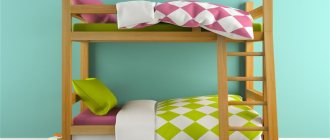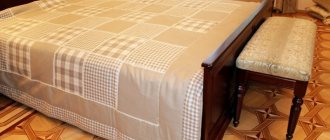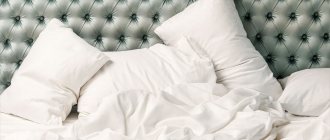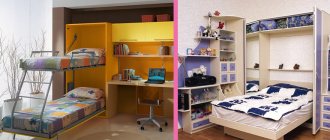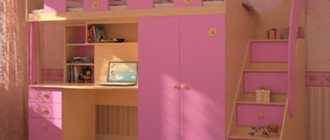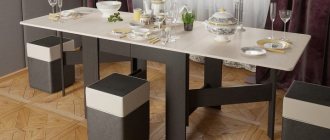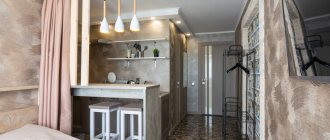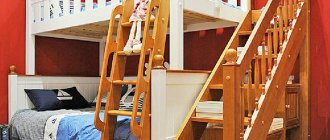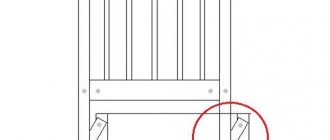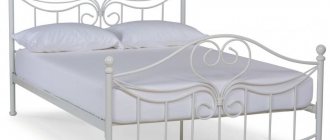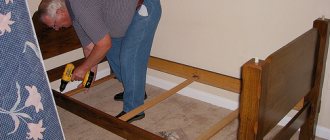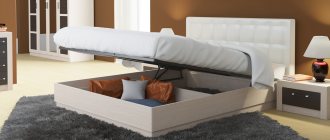What is a bunk bed
A bunk bed is a practical and useful piece of furniture consisting of two tiers.
The upper tier is usually adapted for a sleeping place, and the lower one can be used as an identical or different bed, a folding or standard sofa, an armchair, open shelves, a computer desk and even a small closet. Bunk beds are indispensable in families with several children, because they allow you to properly organize the space in the room. But for parents with one child, such a bed can be an excellent solution if the apartment area is small.
How to choose the size of a bunk bed depending on the age of the child
Generally accepted standard sizes will help you easily choose the right parameters for your age. But it should be taken into account that not all children have a height corresponding to their age. If everything is fine with this, you can safely choose the size of the sleeping place according to the following criteria:
- 0–3 years. At this age, 120 by 65 centimeters is ideal;
- 3–5 years. The baby will be comfortable in a sleeping place 140 by 75 centimeters;
- 5–7 years. The most convenient size would be 160 by 75 centimeters;
- 7–13 years old. Here the bed parameters are already close to adults - 190 by 80 centimeters.
All these parameters are only approximate. You need to understand that some children grow faster, others slower. The quality of their sleep, and, consequently, their health, as well as their academic performance, will depend on the right choice of bunk bed.
Types and features of children's models
Modern manufacturers have recently increasingly expanded their product line of bunk beds. Many interesting varieties have appeared, which in each individual case solve certain problems to improve the ergonomics of the living space.
It is advisable to classify all bunk beds according to the following criteria:
- material of manufacture;
- design and device;
- location of sleeping places;
- form;
- height;
- age and gender of children, etc.
Wooden (solid wood), metal, combined
Most bunk beds are made of wood, because this natural material is environmentally friendly and easy to process, which allows you to implement any design solutions. Wood has many advantages. The best options are models made of beech, alder or oak, but pine products, despite their reasonable cost, are not as durable as analogues made from other wood and will last much less.
Metal bunk beds are more reliable and durable, thanks to which they have an impressive service life. However, they do not have an intricate design and are expensive, which significantly reduces their popularity. In addition, this option is not suitable for every room, because the metal structure looks massive and visually weighs down the interior of the nursery.
The best option for a bunk bed is a combination one, which combines the strength of metal and the warmth of wood. Combined models are the most convenient due to their versatility. The tandem of elements from different materials in one piece of furniture significantly increases its functionality.
Straight, angular
A bunk corner bed, if you look at it from the height of the ceiling, resembles the shape of the letter “L”. It is a structure consisting of an upper standard bed and a lower part located perpendicularly. Such models most often have increased functionality. A sports complex (wall bars, rings, rope) is built into them, allowing children to spend time with health benefits, as well as a desk or niches for storing things, which help not to clutter up the entire room with diverse and bulky furniture.
But this variety also has disadvantages. This option is not the most practical in terms of saving space and takes up a decent amount of space in the children's room. The advantage is that such designs can have not two, but more sleeping places, which is a suitable solution for families with several children.
Straight beds with two tiers are standard models in which the sleeping place is on top, and either another bed or a useful device, for example, a wall, is located below. This option is a bed with furniture attached to it, consisting of several cabinets, shelves, a chest of drawers and even a desk. The main advantage of the model is that it allows you to improve the ergonomics of the space and create an interior in the same style in the room. One of the disadvantages is the large dimensions of the structure.
Stationary, retractable
Stationary beds with two levels can also consist of two beds or be designed in the form of a “loft” bed, when the bed is directly at the top and useful pieces of furniture (table, wall, etc.) below. However, such a bed has a significant disadvantage - it does not transform and takes up quite a lot of space.
Another thing is a retractable (roll-out) bed, the upper part of which is a high sofa, and the lower part is a retractable platform with an additional sleeping place.
Thus, when unfolded, the bed is equipped with two sleeping places, and when folded, it resembles the shape of an ordinary bed or sofa. The main advantage of the design is its compactness and the absence of stairs; the disadvantage is the small number of auxiliary devices.
There are models on sale where the lower tier bed is equipped with an additional third bed.
Low (low), high
All bunk beds are divided according to height into low and high. And the choice in this case will directly depend on the height of the ceiling in the room. The most comfortable distance between the sleeping place and the ceiling should not be less than 90 cm.
With a regular ladder, with a ladder-boxes
Most types of beds with two tiers are equipped with special stairs that make it easy to get from the first “floor” to the second. In some models, the staircase is simple, consisting of a support and rungs. In others, it is more functional, when there are special compartments for storing things between the steps.
With sides on the lower tier, without sides
Photo: Children's bunk bed with an adjustable lower side
When choosing a bed, you should also focus on the age of the children. If one of them is too small, then for its safety it is advisable to purchase a bed with high sides on the lower tier, which will protect it from falling.
For older children, such design solutions are irrelevant.
With table (work area)
The most popular among parents is the “loft” bed, where there is one sleeping place in the upper part, and below there is a work area (desk, desk or computer table). This piece of furniture is relevant for small rooms where it is not possible to fully arrange the furniture.
Transformable bunk wardrobe bed
Another useful multifunctional option for small spaces, allowing you to transform one or both beds into a closet. This solution is optimal for studio apartments, because it allows you not only to save space, but also not to have to look for a suitable place to store bed linen.
For girls, for boys
When purchasing a bed, you should also consider the gender of the child. For boys, designs with wall bars and other sports equipment are more suitable. Girls are more likely to focus on attractive appearance rather than functionality. As a rule, they prefer beds where the lower tier is a comfortable sofa.
How to choose a bunk children's bed
Any furniture intended for children must meet the following basic conditions:
By request, the next post will be on the topic - a bunk bed with a work area for a child who goes to school. We believe you will like it.
- safety;
- environmental Safety;
- great build quality.
At the beginning of operation, instruct children about the rules for safe use of a loft bed!
Simple selection rules will help you make a good purchase:
- a children's bed on two floors must have a strong, massive system and have stable, strong legs;
- the bed must support not only the weight of the child and bedroom accessories (mattresses, pillows, blankets), but also the weight of an adult;
- the upper tier must be equipped with protective sides. A two-tier bed for babies with sides will protect you from falling from a height;
- the design does not have to have corners with sharp ends or protruding fasteners;
- the bed ladder must be equipped with good handrails;
- furniture design should be combined with the interior of the nursery and, of course, should be liked by children.
Loft bed frame for babies
The loft bed frame can be made from materials such as:
- tree;
- metal;
- Chipboard;
- plywood;
- painted MDF.
Products based on MDF, plywood and chipboard belong to the budget segment. When choosing such models, you need to think about the safety of your own children by asking your sales representative for quality certificates for materials.
By request, the next post will be on the topic - a bunk bed for kids with a work area. We believe you will like it.
The most common and functional is considered to be a base made of real wood. In the manufacture of frames, solid oak, beech, and ash are used; pine is the absolute leader in this segment.
Advantages of a pine frame:
- long service life;
- great strength;
- ecology of material;
- availability.
The metal base is more durable, but still such a product can be dangerous; it is also worth saying that the iron bed is inferior to wooden models in aesthetic terms.
When choosing a two-story sleeping place, you need to look at the overall height of the product. The best height for a bed with 2 tiers is 165-175 cm.
Sleeping places
The design of the crib usually has a classic or orthopedic base. A simple base is demonstrated by a solid, flat bottom made of chipboard or plywood. An orthopedic base for a mattress is definitely better, because it will make it possible to maintain an anatomically good position for children during sleep. The orthopedic base consists of a frame with bent lamellas attached to it.
In the next article we will talk about the topic of purchasing a bunk bed for kids in Novosibirsk. Let's try to describe this topic in more detail.
Important properties of a children's multi-story bed are the height of the lower tier from the floor, the distance between floors and the size of the sleeping area. For preschool children, the sleeping place should be located at a level of 30 cm from the floor. For the age group from 7 to 14 years, a good distance is 40 cm, for teenagers - 50 cm.
The distance between the floors should allow the child to sit upright on the bed, however, the upper tier does not have to be too high; a place to sleep close to the ceiling of the room provokes the formation of phobias in the child. Suitable distance between floors is 85-90 cm;
On average, the width of the sleeping area for a children's loft bed is 60-80 cm, and the length of the product varies in the range from 140 to 200 cm. To choose a children's bed with two tiers of the required size, you need to look at the age of the children.
Classic sleeping space dimensions:
- for children under 3 years of age - 120x60 cm;
- from 3 to 6 years - 140x70 cm, 150x70 cm;
- from 7 to 14 years – 160 x eighty centimeters, 170 x eighty centimeters;
- teenage group – 180x90, 190x90 cm.
What additional requirements should be placed on the upper berth?
There are special safety requirements for the upper tier of the crib for children.
Attention should be paid to the interfloor stairs and the protective elements of the upper floor.
A two-tier bed with sides 30 cm high from the surface of the mattress is considered an excellent option.
The staircase between floors must be comfortable and good, made of non-slip materials, and firmly fixed. You should not choose crib models with a strictly vertical ladder; flat parts are much safer. It is better if the staircase is fenced with the tops of the stairs and wide steps. The typical width of the ladder is 40 cm, the suitable distance between the rungs is from 20 to 25 cm.
Mattresses - types and selection rules
Parents' attention should be paid not only to the frame, but also to the mattress. A mattress for a child must have the necessary rigidity and elasticity, helping to distribute the load equally. Two types of mattresses are used for arranging children's beds:
- springless;
- with spring block.
The main good qualities of mattresses without a spring mechanism are a longer service life and the absence of metal elements; the latter factor eliminates the effect of electrostatic and magnetic fields on the child. When selecting the filler for a springless mattress, preference should be given to hypoallergenic, non-toxic material. Among natural fillers, coconut coir and latex are popular, while modern synthetic materials include artificial latex.
Innerspring mattresses consist specifically of the spring itself and additional layers of filler that provide comfort and support. Models of mattresses with dependent and independent types of springs have been demonstrated on the bedroom accessories market. For babies, mattresses with an independent spring block and natural filling are more useful; such bases are closer to orthopedic products. Important indicators for choosing a mattress with a spring block are the diameter of the springs (the smaller the better) and filling density (the greater the number per 1 m2, the denser the base).
If you are concerned about the topic, a photo of a bunk bed with a table and a wardrobe. Follow the link.
Pros and cons of bunk beds for children
It is advisable to consider the advantages and disadvantages of bunk beds depending on the specific model. But different types of construction also have common advantages:
- Saving. In this case, we are talking not just about saving space, but also about relatively low acquisition costs. If you buy several beds per room or separate pieces of furniture, the cost will be higher.
- Versatility. A bunk bed is suitable for children of any age and gender.
- Ergonomics. The design with two tiers helps to properly organize the space even in a small room. Moreover, some models can replace an entire furniture set for a child’s room.
It is worth considering the disadvantages separately:
- increased risk of injury. Some children use bunk beds for play, which often poses a risk of falling from a height.
- massiveness. On the one hand, the design with two levels helps to save space in the room, on the other hand, it is very difficult to move, assemble and disassemble it yourself.
Advantages and disadvantages of 2-tier beds
There are at least three factors that speak in favor of choosing bunk beds.
- The abundance of variations of this type of furniture allows you to use them for different purposes, in different rooms and create a varied interior design.
- A bunk bed is not just compact furniture for sleeping, although, of course, its primary role and advantage is the most efficient use of space.
- No less important advantages include the often low cost compared to purchasing separate sofas and beds of similar quality.
Photo - 72 Efficient use of space with BuildABear Loft Bed with Desk and Storage
As for the shortcomings, they also exist. For some, a problem may be the need to regularly climb to the “second floor” of the bed. Therefore, if those for whom the furniture is selected have a persistent fear of heights, problems with the musculoskeletal system or other disorders, it is worth looking for a model with a minimal height difference or something else. In addition, depending on the purpose and configuration, a bunk bed can be quite cumbersome. In this case, it is worth considering in which direction the advantage is: towards the efficient use of space or its clutter.
Photo - 73 Bunk bed for large and small children
Photo - 74 Bunk bed to save space in the room
Photo - 75 Bunk bed for sisters
Photo - 76 Spacious bunk bed for schoolchildren
Dimensions of a children's bunk bed
Dimensions are no less important for a comfortable sleep. As a rule, designs in furniture stores have standard sizes. But some suppliers make beds taking into account the individual characteristics of the child.
Standard dimensions (length, width, height)
Classic bunk beds have the following standard sizes, depending on the age of the child:
| Age | Dimensions, cm |
| up to 3 years | 120x60 |
| from 3 to 6-7 years | 140x70, 150x70 |
| from 7 to 14 years | 160x80, 170x80 |
| over 14 years old | 180x90, 190x90 |
As for the height, it depends on the height of the ceilings. The best option is a height of 1.65-1.75 m.
Non-standard models
Non-standard bed parameters are determined taking into account the child’s height and build:
- the length of the sleeping place can be calculated using the following formula: the child’s height in cm plus 30-40 cm;
- the width is determined based on the position when the child lies on his back with his elbows bent and his arms spread to the sides, while his hands are closed on his stomach. It should also be taken into account that the distance between the elbows and the edges of the mattress should not be less than 10 cm.
$. Bunk bed. Price
The cost, of course, depends on what type of bunk bed is chosen. Price for the simplest metal bunk beds for workers, military, students, etc. starts from 2000 rubles (although if you look, you can find it for 750 rubles). More aesthetic options will cost more: ordering production or buying a good bed can cost from 4,000 rubles to 20 thousand rubles. Moreover, this price range is valid for almost all types and materials: a metal, wooden bed and a bed made of chipboard can cost approximately the same level. Branded bunk beds with rich decoration and entire furniture sets can cost 20-100 thousand rubles. Forging, wood type, a special type of bed and additional pieces of furniture naturally increase the price of the product.
Customer Reviews
There are many positive reviews on the Internet from parents who decided to purchase a bunk bed for their children. As a rule, many note that it really helps to save space and properly organize the space in the room.
However, you can also find negative reviews about this design on the Internet. Many people note that they are afraid to buy models with two levels for fear of the child falling from a height. Most mothers note as a minus that it is inconvenient to change bed linen on the upper bed.
Buying a bunk bed for a child’s room is a decision that is made by parents individually, taking into account the area of the child’s room, budget, individual characteristics and interests of the child. Despite the variety of models with extensive functionality, this design is not suitable for everyone, because it also has a number of disadvantages.
Bed standards
There are standard sizes of sleeping places for children's beds, according to GOST:
- a bed for a child under 3 years old must have a sleeping bed of 12060 cm;
- a bed for a child from 3 to 7 years old should have a sleeping place 140-150 cm long, and the width of the bed should be 60-70 cm;
- a bed for a schoolchild between 7 and 14 years old should have a base 160-170 cm long and 80 cm wide;
- a bed for a teenager should have a bed 180-190 cm long and 90 cm wide.
When choosing a bunk bed for children, you need to take these sleeping sizes into account. However, it is worth remembering that bunk beds for children are not suitable for children of any age. Toddlers and active children can accidentally fall from the top tier, so postpone purchasing a bunk bed until your child is 3-4 years old.
Sizes of mattresses for children's beds
Requirements for mattresses vary greatly depending on the age of the child. From birth to two years, the baby’s back needs support - at this time the skeletal system is very plastic, and the muscular skeleton is just being formed, so the mattress must be hard and elastic. Then you can transfer the child to a medium-hard mattress. But soft ones should be avoided until the formation of the musculoskeletal system is completed, that is, latex, latexed coconut coir and their combinations.
Standard sizes of mattresses for children's cribs, as a rule, coincide with the standard sizes of sleeping places, but may differ, so the mattress is purchased either at the same time as the crib, or after purchasing the latter and carefully measuring the sleeping place.
The optimal solution for home improvement would be children's bunk beds, photos of which clearly demonstrate the elegance and practicality of such a choice. Beds of this type will become relevant in the case when the children's room has a small area that simply does not allow installing two or more pieces of furniture in one room. After all, it is also important to take into account the additional space in the room, the purpose of which is to give children the opportunity to relax and have a good time having fun. The freed up space can also be used as a sports corner, storage of children's toys, or a desk and study area.
Looking at children's bunk beds, you can't help but notice their photos; I would like to note the excellent design of the structure, while the fact that each model is significantly different from the others is undeniable. The usual type of construction can be chosen, light and practical, without certain frills - a profitable solution for arranging a room for older children.
Or, on the contrary, install a bed made in the shape of one of the most popular characters, which will allow you not only to relax in the room, but also to play at the same time. For example, you can choose children's bunk beds made in the shape of a dragon or a car.
Color options also vary depending on the chosen solution. You can choose one color, or, on the contrary, make the design bright and colorful, which will certainly cheer up your child at any time. Regardless of preferences, the bed will certainly become a decoration and the main asset of the children's room!
